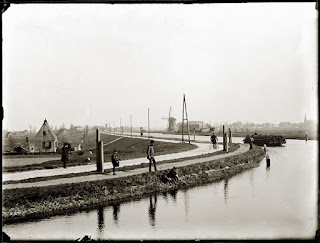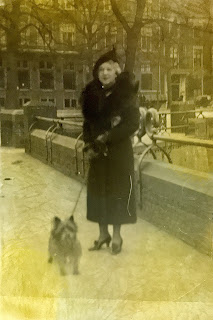Travel - An outing to the island of Ceram
"Travel" is the theme for Week 28 of the 52 Ancestors challenge. Traveling to start life in a new land; travel for work; travel to elope; travel for vacation -- how and why did your ancestors travel?
My great great grandfather Reinier Scherius travelled many miles in the course of his life, simply because he was a public servant within the administration of the Dutch East Indies. Born in Amsterdam, at the age of 22 he was appointed to the office in Palembang, Sumatra. The journey from Amsterdam in 1832 would have taken five months, with a break in South Africa, to stock up.
From Palembang he was posted to Gorontalo, on the island of Sulawesi, and in 1843 he took up the post of Assistent-Resident of Saparua.
In 1846 he decided to explore his domain or area of responsibility and made a trip, an outing as he called it in his article, written for one of the colonial journals, to the island of Ceram, where the fearsome headhunting tribes of the Alfurians lived.
As I read his story, I was particularly intrigued by the fate of his shoes.
My great great grandfather Reinier Scherius travelled many miles in the course of his life, simply because he was a public servant within the administration of the Dutch East Indies. Born in Amsterdam, at the age of 22 he was appointed to the office in Palembang, Sumatra. The journey from Amsterdam in 1832 would have taken five months, with a break in South Africa, to stock up.
 |
| Deck of an East India Ship Jan Brandes (1779-1787) Public Domain Rijks Museum Collection http://hdl.handle.net/10934/RM0001.COLLECT.131430 |
From Palembang he was posted to Gorontalo, on the island of Sulawesi, and in 1843 he took up the post of Assistent-Resident of Saparua.
In 1846 he decided to explore his domain or area of responsibility and made a trip, an outing as he called it in his article, written for one of the colonial journals, to the island of Ceram, where the fearsome headhunting tribes of the Alfurians lived.
 |
| The island Ceram is far right and just below it are the tiny islands of Saparua and Haraku Detail from De Oost-Indische eilanden, Prenten-magazijn voor de jeugd,Aardrijkskunde Publisher: Dirk Noothoven van Goor Collection Rijks Museum Public Domain http://hdl.handle.net/10934/RM0001.COLLECT.553985 |
As I read his story, I was particularly intrigued by the fate of his shoes.
He loses his shoes on the first day of their march across the island. They had set off at five in the morning. A large party of seventy eight natives, of which forty-two were Alfurians, armed with guns and klewangs (machete like knifes) accompanied Reinier Scherius, the Assistant Resident of Saparua and Haraku, and his guests, the Regent of Nolloth and the Orang Kaiji or Village Chief of Makarikie. I try to picture this - a total of 81 men, carrying weapons, food, luggage, tools - somehow finding or following a path through thick forest. I imagine it would have been single file, with the native guides leading the way.
For the first hour they trekked along a fairly good pathway until they reach the river Loewatta which they had to wade over. With its strong currents there was the danger of being carried away by the river and being dumped in the sea only a short distance away. Reinier still had both his shoes on.
Half an hour later they reached the dry, very wide river bed of the Tane, overgrown in several places with shrubs and long grass. For an hour they trekked along this river bed but then had to cross the river Tone, which is cluttered with large boulders and though narrow and shallow was very fast moving so they had to proceed in a zig zag fashion, guided by the Alfurians. Now it happens:
“this incessant crossing hither and thither caused me to lose both my shoes, carried away by the current.”
He is not fazed at all. Carry on regardless, and at eleven o’clock a break was called for.
“…we decided, drenched and exhausted, to rest for a moment. We chose for this the flat on a rock of awesome size, in the middle of the river, around which the water made its way with a deafening roar. Refreshed and cheered by the scenic beauty of our surrounding natural theatre we resumed the same way with renewed courage”.
I followed his story, intrigued by what it reveals about him. He was a fit man for sure, hacking his way through the jungle, getting soaking wet, walking, climbing for nine or ten hours a day, over several days.
 |
| Man in tropical forest, near water. Drawing by Johannes Christiaan d'Arnaud Gerkens Public Domain http://hdl.handle.net/10934/RM0001.COLLECT.243071 |
“..and climbed, even before the first light of day with renewed courage and strength the steep mountain path up ahead; fallen and rotting tree trunks of enormous proportions, which yielded at
the slightest pressure, meant that we advanced but slowly. The ground itself was covered with the fallen leaves of centuries; no sunshine reached the ground shaded by the vault of entwined crowns of grey trunks which by its softness did not betray the sound of footsteps”
He had a reverence for nature but an encounter with a python revealed the trophy hunter.
“Being unarmed, I walked back a few paces, called out to the nearest of our people, to come to me with their parangs, and took them to the place, where, moments before I had seen the monster slide away. Only a short distance from there, we found her, lying unmoving curled up, asleep so it seemed, because the noise we made did not disturb her. Some of the bravest moved forward with raised parangs, and killed her with a few blows; on closer inspection it was revealed to be a so-called oelar patolla; she was over 21 foot in length and as thick as a man’s thigh. After we opened her, we found a still undigested young deer, which will have been the reason for her deep repose. We removed her very beautifully patterned skin and took it back with us in triumph.”
Suddenly they found themselves in the middle of an Alfurian village, having first clambered up the very steep mountain side with both hands and feet:
“Our sudden appearance, especially by me, likely the first European who trod this ground, caused a big upset, because our approach had remained undetected; some women and children, in the most perfect state of innocence (as if they had nothing in common with the original sin of the first human couple) ran screaming hither and thither, while the men, who at first suspected us of having hostile intentions, raced to fetch their weapons and put up resistance. A few words from the accompanying Alfuren orang kaija, from the southern, belonging to my region, beach village, Awaija, were sufficient to put them at ease and soon the whole scene looked at peace again.”
He was shown around the village and he commented on the practice of head hunting and the evidence visible inside the dwellings.
After a few hours the whole party left and now another difficulty confronted them. But one member of the party refused to climb down the other side, which was even harder than the climb up and wanted to turn back on his own the way they had come. Reinier wouldn't hear of this and insisted that he change his mind and so finally, ”we at last, more crawling than walking, arrived below.”
It took another day and night, crossing over the bay for Reinier to reach civilisation and the post Wahaaij, his ultimate destination. He was met by the sentry of the fort and now at last he mentioned his shoes again:
“He seemed to be somewhat doubtful upon hearing my name and station, because he regarded me very slowly from head to toe, and I must admit frankly, that my bare feet, in half soled shoes, torn trousers and the rest of my attire matching this, fully entitled him to do so.”
He must have had a second pair.




Wow! what a fascinating tale. It's so great that you have that document & could translate it. Thanks for sharing. --Brian L.
ReplyDelete